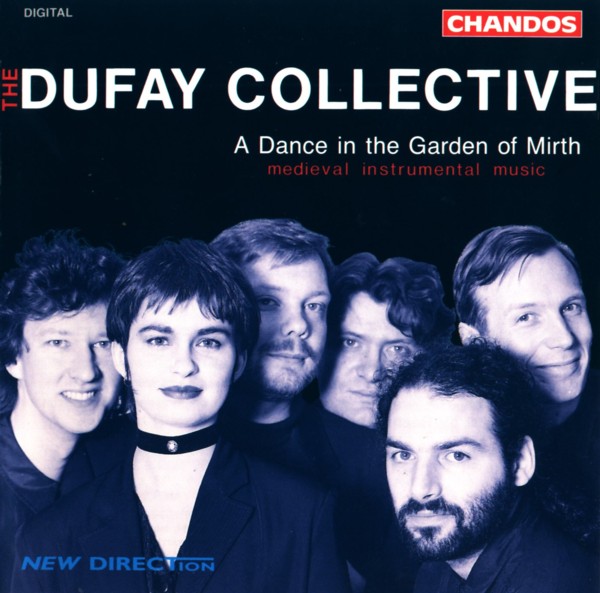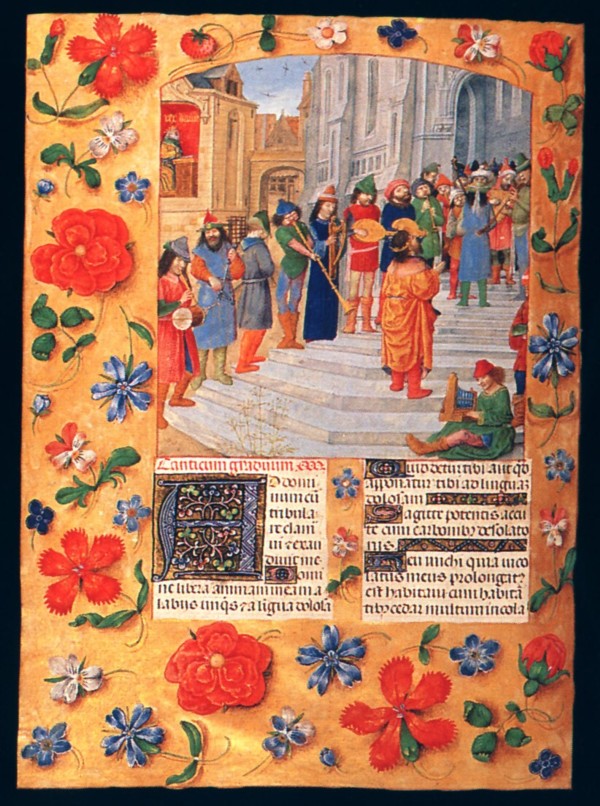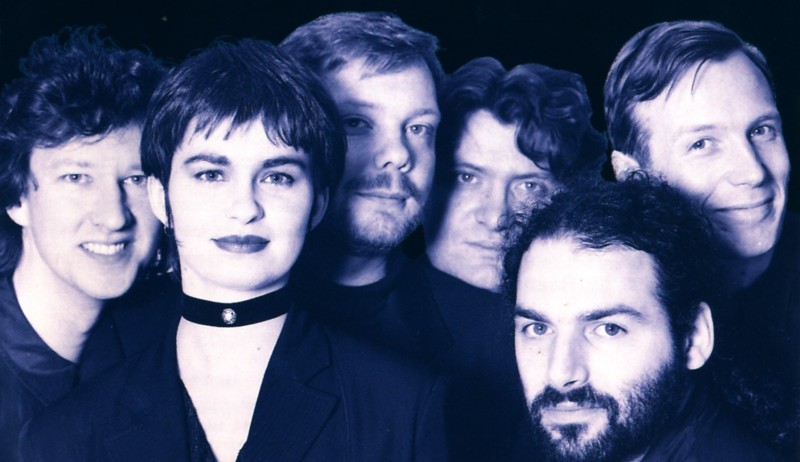
medieval.org
Chandos 'New Direction' 9320
1994
1. Istanpitta 'Ghaetta' (Italian 14th century) [6:48]
GL · RM rebecs, SP vielle, WL long-necked lute, PB percussion
2. [La prime estampie real] (French 13th century) [3:29]
WL flute
3. La uitime estampie real (French 13th century) [5:07]
PS harp, RM percussion, GL gittern
4. La seconde estampie royal (French 13th century) [2:39]
WL · PB recorders, PS harp
5. La tierche estampie royal (French 13th century) [2:27]
GL · SP vielles, PS harp, WL, PB recorders, RM tabor
6. Danse (French 13th century) [2:31]
WL · GL shawms, PB slide trumpet
7. Retrove (English 14th century) [5:47]
PS organ
8. Trotto - Salterello (Italian 14th century) [7:45]
GL · SP vielles, RM rebec, WL long-necked lute, PB tabor , PS percussion
9. La quinte estampie real (French 13th century) [2:14]
GL · PB · WL, 3 holed pipes & tabors
10. Istanpitta 'Belicha' (Italian 14th century) [10:18]
GL · SP vielles, PB & WL recorders, RM · PS percussion
11. Istanpitta 'Isabella' (Italian 14th century) [7:31]
RM fretless lute, GL, SP vielles, PS harp, PB · WL percussion
12. Salterello (Italian 14th century) [4:42]
WL bagpipes, GL shawm, PB slide trumpet, PS tabor, RM · SP percussion
THE DUFAY COLLECTIVE
Paul Bevan — slide-trumpet, recorder, pipe & tabor, percussion
Giles Lewin — vielle, rebec gittern, shawm, pipe & tabor
William Lyons — flute, recorder, bagpipes, shawm, pipe & tabor, long-necked lute, percussion
Raphael Mizraki — lutes, rebec, percussion
Susanna Pell — vielle, percussion
Peter Skuce — harp, organ, percussion
Sources
Tracks 1, 8, 10, 11, 12 — from British Library Add. 29987 f.56-64v
Tracks 2, 3, 4, 5, 6, 9 — from Le Manuscrit du Roi fonds français 544, fols 5r, 103v-104v.
Track 7 — from British Library Add. 28550 (Robertsbridge Codex), fol.43r, v.
Performing editions by The Dufay Collective © 1994
The Instruments
· vielle, GL (Ian Laidlaw 198P Scotland)
· vielle, SP (Gary Bridgewood 1988, London)
· rebec, RM (Raphael Mizraki 1992, London)
· rebec, GL (James Bisgood 1985, London)
· harp (Tim Hobrough 1991, Scotland)
· fretted lute (Stephen Barber 1983, London)
· gittern (Tom Eve 1982, London)
· fretless lute (traditional Turkish 1987, Istanbul)
· long-necked lute (traditional Turkish 1987, Istanbul)
· slide trumpet (Nicholas Perry 1992, London)
· bagpipes (José Reboredo 1992, Lugo)
· shawm, WL (Eric Moulder 1987 London)
· shawm, GL (Linsey Pollack 1988 Australia)
· recorders (Moeck 1979 & 1988 Germany)
· flute (R.K. Mohan 1990 Delhi)
· 3 holed pipes (traditional English 1990, London)
· organ (Menders & Ca 1984 Landon)
· tabors (Leo Stevenson 1989, London)
· other percussion (traditional Moroccan & Indian)

That
the role of the instrumentalist in medieval life was a major one is
indisputable. Quite what a musician played, in what manner and with whom
is a subject of much debate. Unfortunately, we have very little
evidence to rely on, due largely to the fact that before the 13th
century instrumental music simply did not have any relevance to the
medieval theorist, as we can see from this extract by one of the
earliest and most influential writers on music:
Those musicians
dedicated to instruments, and who spend all their efforts upon them such
as players of the cithara and those who show their skill on the organ
and other musical instruments, are exiled from the true understanding of
musical science and are of servile condition, nor do they bear anything
of reason, as has been said, for they are wholly destitute of interest
in scientific enquiry.
Boethius (d. 524) De Instrutione Musica
Only in the remarkable treatises of Jerome of Moravia (Tractatus de Musica) and Johannes de Grocheo (De Musica)
do we see an acceptance of the function and worth of the
instrumentalist, and at least a suggestion of the repertoire and even
their playing styles.
So few examples of instrumental music
survive that it is almost impossible to conceive the quantity and
variety of music available to the medieval player. Before the 15th
century most musicians would have been illiterate — not a hindrance at
all when one considers that aural transmission of tunes and words was
the norm. Improvisation would also have been common practice. Indeed, as
with troubadour and trouvere poets who could improvise their lyrics, an
excellent extemporisor of estampies would be much sought after and
highly valued.
This dearth of extant musical examples from such a
rich aural tradition is frustrating to say the least but, given this,
the question arises as to why these instrumental pieces were written
down at all. They are all finely wrought compositions and may well have
been preserved for that reason alone.
The 13th century French Manuscrit du Roi contains, in the main, songs by Trouvere composers. Also included are eleven dances; eight 'Royal' Estampies, a Dansse Real, a Danse
and an untitled piece. The estarnpies are numbered from two to eight,
with what is probably number one (La Prime) in fragment form
(reconstructed for this recording). It is remarkable that these untexted
instrumental pieces have clear and unmistakable titles, although why
they are named in such a manner is difficult to say. One solution might
be that they were intended to be performed in sequence, or perhaps just
as likely is that they were simply written down in order and identified
thus. The notation is slightly ambiguous which gives rise to a number of
rhythmical uncertainties. It is clearly in a form of developed modal
notation, with notes in ligatures but with differing shapes to indicate
their value.
The Italian dances, like the French, are to be found
inserted in a song collection amidst a compendium of songs by Landini
and other well-known Trecento composers compiled some time towards the
end of the 14th century. Under a general heading lstanpitta there
are fifteen dances and later four tenors for improvising upon. All the
instrumental pieces have titles, some with merely their generic name — salterello, trotto, rotta whilst eight have more exotic names such as those heard here — Ghaetta, Belicha, Isabella.
No satisfactory explanation has emerged as to the meaning behind such
bizarre titles. They could be associated with a particular event or
place (there is a town called Gaeta near Naples, and one called La Rotta
near Florence). They may be referring to a vocal original upon which
the melody is based, or quite possibly could be the precursors of the
titled balli which are found in the early 15th century dance
manuals of Domenico da Piacenza and Guglielmo Ebreo da Pesaro. There is
little or nothing musically that suggest a solution to this conundrum.
These
Italian dances are also notable for the manner of their layout on the
manuscript page. Personal experience has proved that to write out in its
entirety a piece such as 'Isabella' is both time and space consuming
and must have been so for the scribe who put these pieces to paper. The
solution employed is an almost bewildering variety of signs: pointing
hands, maltese crosses, helmets, circles intersected with crosses and so
on. These are to show the reader when to repeat a section and where to
return to at various points in each of the sections of the istanpitta.
Even more confusing is that it is not always clear what the signs mean,
and sometimes they have been entirely omitted. Despite these
inconsistencies it is clear that this is a performer's manuscript, with a
practical solution achieved in order for the reader to play the piece
reading from just one page.
The only English item on this
recording comes from the so-called 'Robertsbridge Fragment' which
contains three pieces in an early form of keyboard tablature with neumes
for the upper voice and letters for the lower. There is an almost
illegible word in the margin which may or may not be a title. We have
adopted the accepted interpretation of this as 'Retrove'.
Exactly
when this instrumental music would have been heard is hard to
determine. It was certainly essential for ceremonial and state occasions
and there were always weddings, banquets and dances to occupy the life
of a successful minstrel. Harder to confirm is exactly how many
musicians would have been engaged to play together at any one time, or
whether a soloist or duet was the standard performing unit which would
have been augmented to make a more impressive sight and sound on special
occasions. Slightly clearer are the combinations of instruments used,
each having its own function, for example loud instruments such as
shawms and trumpets would rarely if ever have played with the soft
indoor instruments such as vielles, harps and lutes. Wind instruments
are more difficult to place in the overall scheme, having been largely
dismissed and ignored by theorists as inferior. This does not imply that
they were not used; on the contrary, depictions and references are
numerous. Whether they would have combined with other types of
instrument is harder to confirm, but certainly reeds, trumpets and
percussion make an impressive noise, and there is an undeniable charm in
the sound of soft winds and strings combined. The Istanpittas and
Estampies on this recording may well have fulfilled a number of roles —
as music for communal dancing and for professional exhibition dancing,
for general entertainment or for virtuoso recitals.
Given the
paucity of evidence and material it is always necessary to exercise a
degree of speculation as to the nature and character of this music. Our
intention here has been to use the available repertoire to demonstrate
the multifarious instrumental combinations and timbres, soft and loud,
solo and ensemble that would have enriched the world of the medieval
listener.
© 1994 William Lyons

The Dufay Collective
was formed in 1987 to explore the wealth of music from the Middle Ages
and Renaissance. Sell-out performances in London's concert halls and
major festivals throughout Europe, Russia, Hong Kong, Australia and the
Middle East have established the group as one of Europe's finest early
music ensembles. They have also made numerous radio, film and television
appearances.
The Dufay Collective aims to present concerts that
are both informative and innovative, recreating the variety of
instrumental and vocal styles heard throughout this rich and colourful
age. The individual members' versatility and virtuosity has won critical
acclaim and the enthusiasm of audiences worldwide.
This is the group's first CD for Chandos Records.
• A Chandos Digital Recording
• Recording Producer and Sound Engineer: Nick Parker
• Editor: Andrew Lang
• Recorded at St. George's Church, Brandon Hill, Bristol on 22-24 November 1993
• Front Cover Photograph by Coneyl Jay
• Sleeve Design: Penny Lee • Art Direction: Sarah Haines
Thanks to Leo Stevenson, Dai Miller and Torn Eve for their support